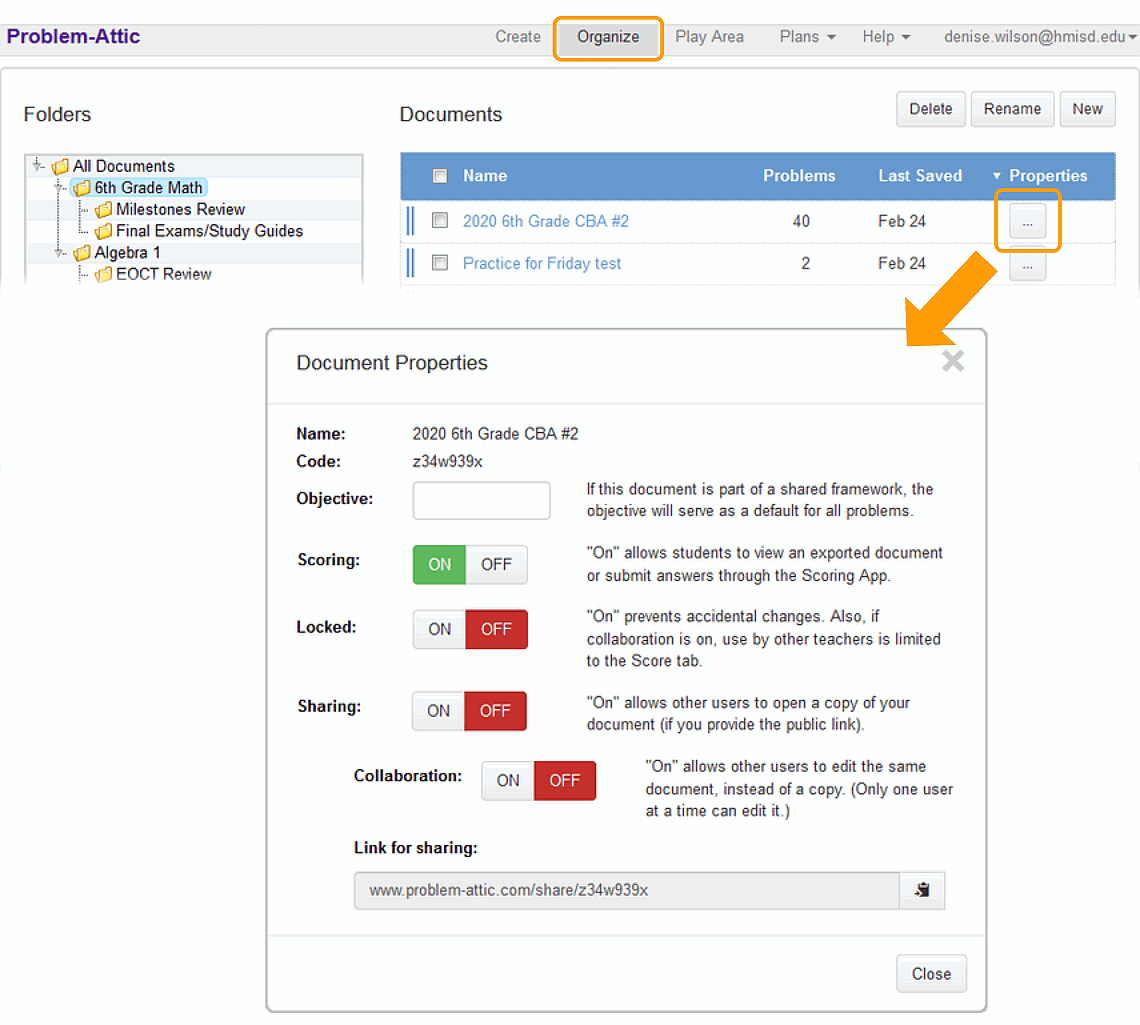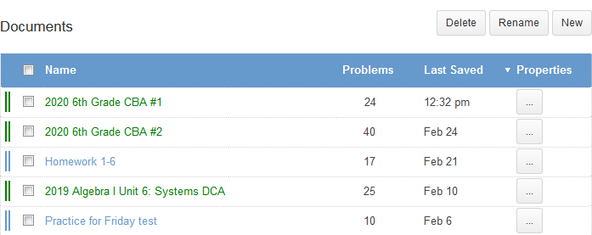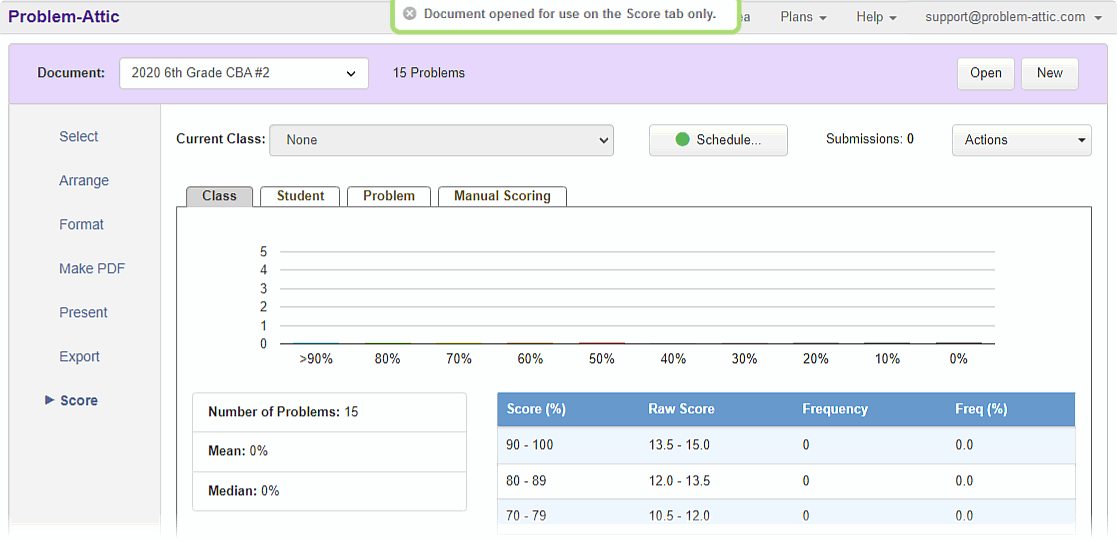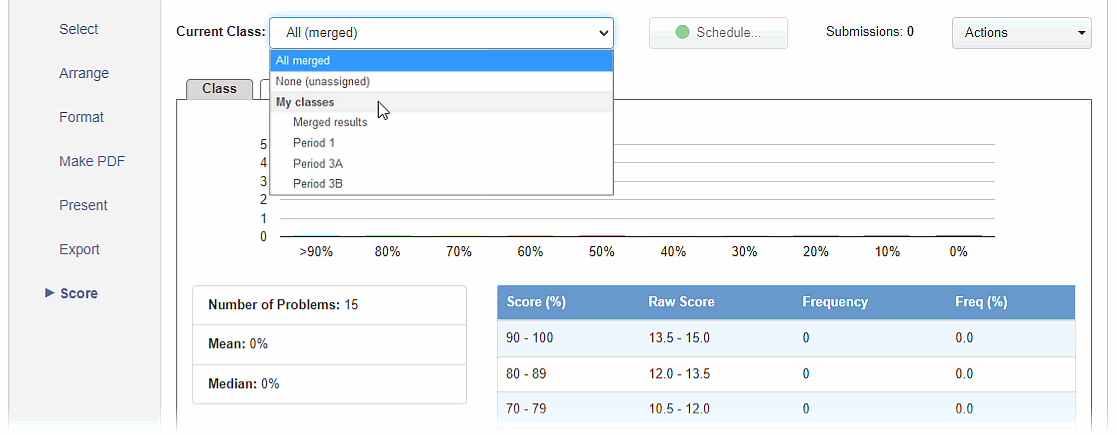Collaboration mode: locking and scoring
Problem-Attic has two options in the Document Properties dialog which help with common benchmark assessments (CBAs). They make it possible to merge test results from different teachers’ classes. The options work especially well with “virtual classes”, which you can read about here.
To open the Document Properties dialog, go to the Organize page. Then click the three-dot button next to a document title, as shown here:

The Objective field is for use with the Framework Builder, which you can read about here. Below it are these four switches:
Scoring
This switch does the same thing as on the Score tab. When on, students can submit results through an online test or answer sheet. If you turn off scoring, then Problem-Attic will not let students start the online test, and it won’t accept any more results for that particular document.
Locked
This switch prevents accidental changes to a document. When a document is locked, you can still download a PDF and make use of the export and score tabs, but you won’t be allowed to add/remove problems or change the formatting. This may be desirable for something like a final exam, after it’s been proofread. (If you spot a mistake later and want to fix it, you can return to the properties dialog and unlock the document.)
Note: a locked document behaves a little differently when the collaboration switch is also turned on. Please see the next section for more information.
Sharing
This switch allows other teachers to make use of your document. The idea is simple: if you turn on sharing and provide them with a link, then they can open a copy of your document in Problem-Attic. Because it’s a copy, they’re able to make changes without affecting the source document in your account. For more information about sharing, please see this page.
Collaboration
This switch changes the sharing behavior described above. If the collaboration switch is on, and if you share the link with other Problem-Attic users, then they can edit the same document that’s in your account (not a copy of it). This may be advantageous if other users need to add or edit questions, and you don’t want to pass links back-and-forth.
Note: There are tradeoffs between regular sharing and what we refer to as “collaboration mode”. In fact, it’s safest to keep collaboration off unless you really need joint editing capabilities.
More about collaboration
When collaboration is on, it’s still necessary to share a link with other Problem-Attic users. When they click the link, the document will appear in their accounts, and they can make changes to it, just like any other document. To stop them from making changes, you can turn off collaboration at any time. This will remove the document from their accounts.
As mentioned above, there are tradeoffs between regular sharing and collaboration mode. With regular sharing, documents are copied. Changes in one account do not affect another, and if a document is passed back-and-forth with links, then you have a history of changes. In collaboration mode, there is no history; just one document is being worked on. More importantly, there is no undo feature. For that reason, you should be careful about when you turn on collaboration mode and with whom you share a link. You may want to establish rules about what “collaborators” are allowed to do.
Here are a few other points about collaboration mode.
-
Only one user at a time can have the document open in Problem-Attic. That is, in collaboration mode, there is no simultaneous editing. The word collaboration simply means everyone is able to work on the same document.
-
To keep one user from monopolizing the document, there is a 15-minute timeout. If the document is not changed for that amount of time, then another user can open it.
-
After editing is done, it’s a good practice for the owner of the document—the user who shared the link—to turn off collaboration. The main reason for leaving collaboration turned on is to combine it with locking, as explained below.
-
Turning off collaboration removes the document from all other accounts. The link to it, however, remains the same. This means you have two options afterward:
▸ You can turn off sharing at the same time as you turn off collaboration. Then the link can’t be used again.
▸ You can leave regular sharing turned on and continue to provide the link to other users. Then they can open a copy of the document, which presumably is in its final proofread form.
-
Documents with collaboration mode turned on are shown in green on the Organize page. This makes them easier to identify. Only the owner can delete the document. If a collaborator selects the document on the Organize page and clicks the Delete button, it will get removed only from that account. The owner (and any other collaborators) will still see it.

Collaboration and locking
If the Collaboration switch allows other users to edit a document, then why would you also want it to be locked? The answer: it’s a signal to Problem-Attic that other users can open the document, but they can use it only for scoring.
When collaboration and locking are combined, a document effectively becomes a common benchmark assessment (CBA) or shared test. This allows multiple teachers to administer the same test, and see results for their students, while the owner of the document has access to all of the results and can view them by teacher or class or merged together.
It’s important to understand that testing across multiple classes does not require collaboration and locking to be turned on. When they are both on, Problem-Attic assumes that the owner of the document is the person in charge of the test. The person could be, for example, a lead teacher, department head or district specialist. If there’s no reason for results from multiple classes to come into a single account, then regular sharing can be done instead.
For a common benchmark assessment, here is the typical workflow:
-
A document is created in one teacher’s account. Optionally, collaboration is turned on for editing and proofreading by other teachers.
-
When the document is ready to be administered as an online test (or as a PDF with an answer sheet), then the owner turns on collaboration and locking.
-
The owner shares the document link with other teachers who are going to administer the test and who were not already collaborators.
-
When a teacher clicks the link, or re-opens the document, the teacher is sent directly to the Score tab. (No other tab is available on the Create page.)

-
A teacher can administer the test in the usual way, by giving students a link or by having them scan a QR Code. Optionally, a teacher can use “virtual classes”, which are described here.
-
Teachers see results for their students only, except for the owner of the document, who can see them all. If virtual classes are used, then teachers and/or the owner can view results merged or separated by class. (Of course the owner can download all results in a CSV file and share them.)

-
The owner is in complete control of the test and answer sheet. This includes turning on/off the Scoring button. On the Score tab, a teacher who is administering the test can click only the Classes and Links buttons. The Settings button is available only to the owner.
-
At the end of the test, and after teachers have viewed results for their students, the owner can turn off collaboration and locking. This removes the document from other accounts, and it also removes the student results. The results are still available to the owner, merged together, unless the owner clears them.
We hope you like this new method of sharing tests. Again, it’s totally optional. If you prefer to keep results separate, then do your testing with collaboration mode turned off. Documents will then be copied, and there will be no connection between Problem-Attic accounts.
If you need any help with collaboration mode or have suggestions for improving Problem-Attic’s scoring app, please write to us at support@problem-attic.com.